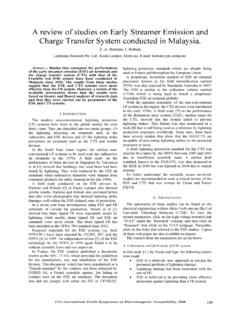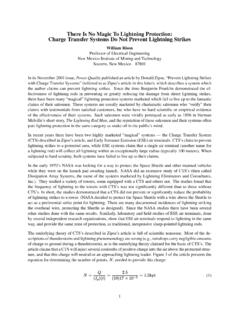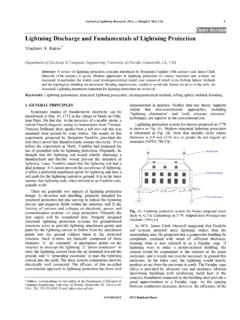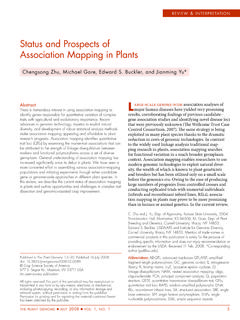Transcription of REVIEW OF FAILURES, CAUSES & CONSEQUENCES IN THE …
1 REVIEW OF FAILURES, CAUSES & CONSEQUENCES IN THE BULK STORAGE INDUSTRY W. Atherton1 and J. W. Ash2 Liverpool John Moores University, Faculty of Technology and Environment, School of the Built Environment, The Cherie Booth Building, Byrom Street, Liverpool L3 3AF, UK ABSTRACT The cataclysmic events, which occurred at the Buncefield Oils Storage Depot in Hertfordshire on Sunday 11th December 2005, resulted in what is widely regarded as the largest explosion in Europe since the Second World War. This event placed the bulk storage industry in the spotlight, raising many yet unanswered questions. Accidents of this nature involving the catastrophic failure of tanks used for the storage of hazardous liquids are rare, and the risk of such incidents occurring is estimated to be low, somewhere in the region of 5 x 10 6 per tank year (Thyer et al 2002).
2 In contrast to this statistical approach, Michels et al (1988) adopted the view that a tank will fail somewhere sometime . Causalities of such events vary; the CONSEQUENCES however are ordinarily the same, incurring environmental, financial and infrastructure losses. A REVIEW of the various CAUSES of failures aims to highlight the extent of the problems, which have occurred in the bulk storage industry together with the environmental and human impact of such incidents. Through a process of spill modelling the magnitudes of such losses have been identified across a range of scenarios. Recent results have indicated that the losses incurred during less dramatic modes of failure can ultimately be significant. This gives rise to the conclusion that a suitably practicable means of mitigation has to be identified and implemented if the levels of potential risks are to be suitably controlled.
3 Keywords: bulk storage, catastrophic failure , environmental impact, hazardous liquids, risks. INTRODUCTION The failure of above ground atmospheric storage tanks, of which a variety of types are in use around the world, can be liable to failure . Types include open top tanks with or without floating roofs and closed-top tanks either with or without floating roofs. Within the European Union (EU) the specification for the design of such tanks is covered by BS EN 14015:2004. The United States Environmental Protection Agency (USEPA) commissioned a study to investigate the common sources of failure and stated that a significant factor in tank 1 E-mail: 2 E-mail: farm accidents is human error.
4 The study covering the ten-year period (1990 - 2000) highlighted that the number of accidents at long-term storage facilities had remained relatively constant. Of the 312 accidents at tank farms examined in this period it was found that operator error accounted for 22%. Additionally, 55% were attributable to tank failure , 10% to valve failure , 4% to pump failure and 3% to bolted fitting failure . Human error also accounted for 100% of accidents that resulted in fatalities, 88% involving stock loss and 87% of property damage, with the root cause attributed to overfilling/over-pressurisation (USEPA 2000). The failure of bulk storage tanks can be attributed to a number of CAUSES including human error, poor maintenance, vapour ignition, differential settlement, earthquake, lightening strike, hurricane, flood damage and over-pressurisation.
5 Such incidents have highlighted the need for the proper assessment of potential risks and the requirement for suitable methods of mitigation. MAJOR INCIDENTS There have been numerous storage facilities around the world damaged by earthquakes including major incidents in Alaska USA 1964, Chile in 1960, and two in Japan, Niigata in 1964 and Tokachi in 2003. The incident in 1964 at Niigata resulted in the loss of containment of several tanks due to damage sustained during the earthquake, which added to the ensuing inferno and continued to burn for 13 days. This incident highlighted several problems including that of floating roofs becoming dislodged and jamming, with the resulting fire being attributed to sparks from the damaged roof being shaken violently.
6 More importantly, this was the first time that the phenomena of liquefaction had been observed, raising concerns over the integrity of storage tank foundations at similar coastal locations (Akatashi and kobayashi 2006). It is estimated that lightning accounts for 61% of all accidents in storage and processing activities, where natural events are identified as the root cause of the incidents. In North America, 16 out of 20 accidents involving petroleum products storage tanks were as a result of lightning strikes. Persson and L nnormark (2004) in a REVIEW of fires in the petroleum industry claim there have been 150 tank fires in a 52-year period as a result of lightning. Some of the more recent incidents include Brisbane, Australia 4th June 2003, where a floating roof crude tank was struck by lightning.
7 Nigeria, 20th July 2002, 180000 bbl (one blue barrel is equal to 42 gallons) were lost when fire fighters failed to gain control of a rim fire caused by a lightning strike. Poland 5th May 2002, a 10,000m tank was destroyed as a result of being struck by lightning, this was compounded by the failure of the semi-fixed fire fighting system. Kansas, USA 21st August 2001, five tanks were destroyed in one incident after fire spread from a tank which had been struck by lightning. Naples, Italy 21st December 1985 During a filling operation, fuel overflowed through the roof of a floating roof tank for almost an hour and a half. An estimated 700 tonnes of fuel escaped into the secondary containment. The pool of liquid covered the bund area of the tank and the adjacent pumping area, which was connected through a drain duct.
8 The spill was followed by a vapour cloud, which rapidly formed and ignited, the source of the ignition being a pumping station. The explosion resulted in the injury of five personnel, and the destruction of the facility. Twenty-four tanks were destroyed in the fire, together with the failure of numerous pipelines, which contributed to the fire, and the loss of the main fire-fighting control centre. The fire lasted for seven days (Clark et al. 2001). Pennsylvania, USA 16th October 1995 Five workers were killed when two tanks exploded at the Pennzoil Product Company Refinery. A welding operation was in progress on a service stairway sited between the two waste liquid storage tanks. One tank failed along its bottom seam, the shell being propelled vertically away from the base as a result of rapid over-pressurisation caused by ignition of combustible vapour.
9 The tank contents were instantly released, igniting the contents of the second tank, this also exploded, releasing its entire contents. There was no secondary containment surrounding these tanks and the surge of burning liquid rapidly spread across the entire site, damaging another thirteen storage tanks. The contents of another five other tanks were ignited, resulting in the loss of 95,000 gallons of solvent and fuel oil (USEPA 1998). Delaware, USA 17th July 2001 One worker was killed and eight injured, when a large sulphuric acid tank exploded. The explosion was the result of sparks from hot work on a catwalk above one of several tanks on the site, entering a tank through corrosion holes. Due to the subsequent ignition of flammable vapours, the tank shell was propelled away from its base resulting in a significant volume of sulphuric acid being released into the environment.
10 An estimated 660,000 gallons of acid was released, with extensive environmental damage including a large quantity of the escaping material entering the Delaware River killing thousands of fish and other wildlife. The operator, Motiva, part of the Premcor refining group were ordered to pay costs of $58 million, this included a sum of $36million to the widow and family of the employee killed in the accident. An additional $24million was also deemed payable in fines for various environmental violations (US Chemical Safety & Hazard Investigation Board 2002). Belgium, 25th October 2004 A storage tank failed catastrophically releasing its entire content of 37,000m of crude oil. It is estimated that only 3m escaped the secondary containment during this incident, this was a result of a combination of factors.











